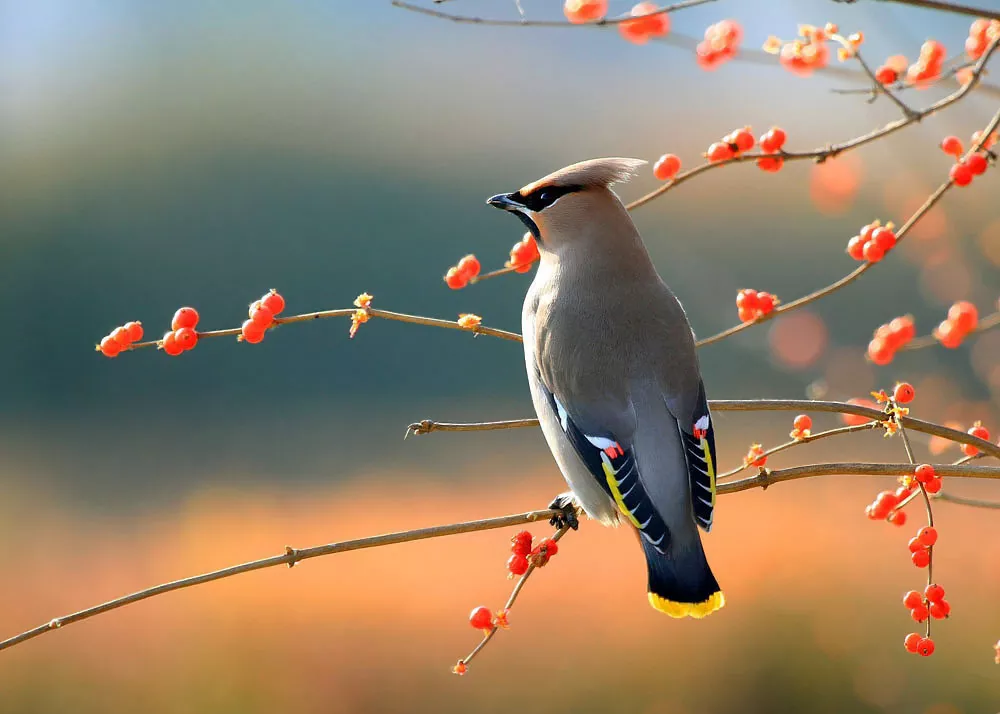The Bohemian Waxwing (Bombycilla garrulus) is a captivating songbird known for its distinctive appearance and enchanting calls. Found primarily in northern regions of North America, Europe, and Asia, this species has fascinated ornithologists and bird enthusiasts for centuries. One of the key aspects of understanding any species is delving into its dietary preferences and foraging habits. In this article, we will explore what Bohemian Waxwings eat, their preferred food sources, foraging strategies, and the ecological significance of their dietary choices.
Dietary Composition of Bohemian Waxwings
The diet of Bohemian Waxwings is diverse and largely dependent on the availability of food sources in their environment. These birds are known for their frugivorous tendencies, with a significant portion of their diet comprising various types of fruits. During the breeding season, they feed on a wide array of berries, such as juniper, hawthorn, and mountain ash berries. The consumption of these berries not only provides essential nutrients to sustain the birds but also contributes to seed dispersal, a crucial ecological role that benefits plant communities.
The Role of Insects in the Diet
While Bohemian Waxwings are primarily frugivorous, their diet is not limited solely to fruits. Insects also play a role in their dietary habits, especially during the nesting season. Insects provide an essential protein source, vital for the growth and development of the waxwing chicks. Insects, such as caterpillars and other arthropods, are captured on the wing or gleaned from vegetation. This dual dietary approach showcases the waxwings’ adaptability to the changing nutritional requirements throughout their life cycle.
Foraging Strategies Of Bohemian Waxwings
Bohemian Waxwings exhibit intriguing foraging strategies that highlight their agility and coordination. Flocks of these birds are often observed foraging in a synchronized manner, moving quickly and efficiently through their environment. They use their acute vision to detect food sources, and their pointed crests, sharp beaks, and specialized digestive systems enable them to efficiently consume berries and insects. The birds are known to engage in behaviors such as hovering flight and mid-air plucking of fruits, showcasing their remarkable adaptability to various foraging conditions.
Seasonal Variations in Diet
The dietary preferences of Bohemian Waxwings exhibit seasonal variations in response to changes in food availability. During the colder months when fruits are scarce, these birds may shift their focus to urban areas where ornamental trees and shrubs often provide a consistent source of berries. This behavior has earned them a reputation as “irruptive” birds, as they can suddenly appear in areas far from their usual range in search of food. The ability to adapt their diet and foraging locations highlights their resilience in the face of changing environmental conditions.
Ecological Significance of Bohemian Waxwings’ Diet
The dietary choices of Bohemian Waxwings have important ecological implications. By consuming a variety of fruits, these birds contribute to the dispersion of seeds over a wide area. This role in seed dispersal aids in plant propagation and maintains the genetic diversity of vegetation. Furthermore, the consumption of insects not only sustains the waxwing population but also helps control insect populations, playing a role in maintaining the balance of local ecosystems.
Conservation Considerations
Understanding the dietary preferences of Bohemian Waxwings is vital for their conservation. Changes in climate, habitat loss, and alterations in food availability can impact their population dynamics. Conservation efforts should focus on preserving the diverse habitats that provide both fruits and insects, ensuring the waxwings have access to adequate food sources throughout the year. Urban planning that incorporates native fruit-bearing plants can also contribute to maintaining healthy waxwing populations, even in urban environments.
Conclusion
In conclusion, the Bohemian Waxwing’s dietary preferences and foraging habits are a testament to their adaptability and ecological significance. With a diet encompassing a range of fruits and insects, these birds showcase their ability to thrive in diverse environments and contribute to the health of their ecosystems. The understanding of their dietary habits is crucial for their conservation and underscores the interconnectedness of species within their habitats. As we continue to study and appreciate these captivating birds, let us also strive to protect their habitats and the resources they rely upon for their sustenance.
FAQs About Bohemian Waxwing
Q: Where can I find Bohemian Waxwings?
A: Bohemian Waxwings are native to northern regions, particularly in North America, Europe, and Asia. During the winter, they often move southward in search of food and can be seen in various habitats, including forests, orchards, and urban areas.
Q: What does a Bohemian Waxwing look like?
A: Bohemian Waxwings have a unique appearance with a sleek grayish-brown body, black mask-like markings around their eyes, and a distinctive crest on their head. They also have waxy red tips on their secondary wing feathers, which give them their name.
Q: Do Bohemian Waxwings migrate?
A: Yes, Bohemian Waxwings are known for their nomadic behavior. They are highly mobile and often move in search of food, particularly during the winter when they migrate to more temperate regions.
Q: Are Bohemian Waxwings social birds?
A: Yes, Bohemian Waxwings are quite social and often form large flocks, especially during the winter months when food is scarce. These flocks can sometimes include hundreds of individuals.
Q: Do Bohemian Waxwings have any unique behaviors?
A: One unique behavior of Bohemian Waxwings is their habit of passing berries from one bird to another in a line, which helps them share food within the flock. This behavior is known as “gifting.”
Q: Can I attract Bohemian Waxwings to my backyard?
A: If you live in an area where Bohemian Waxwings are present, you can try attracting them by offering fruit-bearing trees and shrubs in your yard. Planting species like juniper, mountain ash, and others could potentially attract these birds during their winter migrations.


 Facebook
Facebook  Instagram
Instagram  Youtube
Youtube 